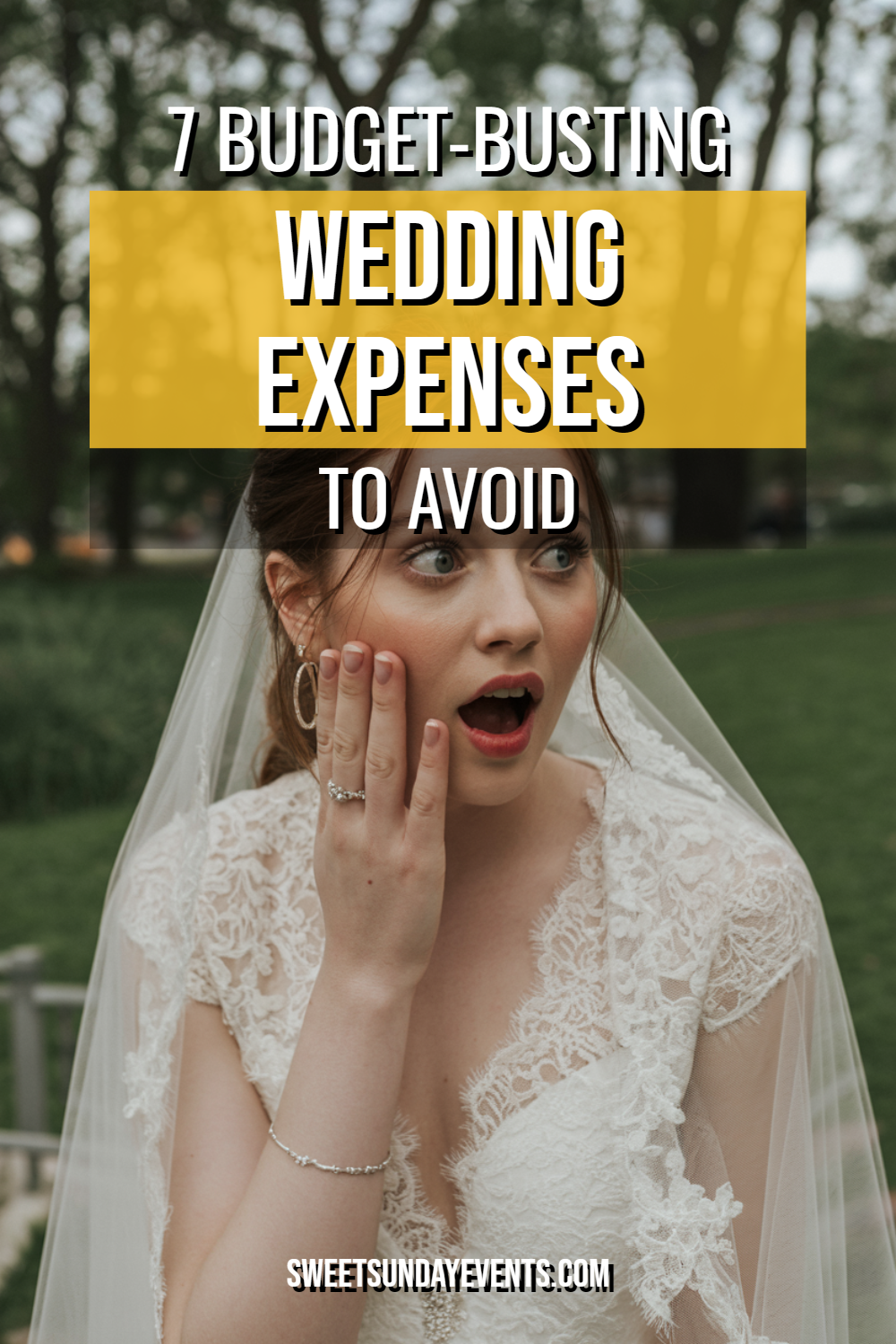Planning a wedding can feel like navigating a financial minefield where every vendor seems to have a “premium package” waiting to explode your budget.
After witnessing countless couples drain their savings on unnecessary extras, I’ve identified the most common money traps that can turn your dream day into a financial nightmare.
Let’s dive into the seven expenses that consistently blow budgets out of the water—and how to sidestep them without sacrificing your vision.
1. The Designer Dress Drama
Wedding dress shopping can quickly spiral from fairy tale to financial horror story. Bridal boutiques are masterfully designed to make you feel like you need the most expensive gown in the store, complete with a veil that costs more than your monthly rent.
The average wedding dress costs between $1,000-$3,000, but many brides find themselves talked into gowns costing $5,000 or more.
Add alterations, undergarments, shoes, and accessories, and you’re looking at a single outfit that could fund a decent honeymoon.
Sample-Size Pressure Tactics
Boutiques often only carry sample sizes 8-10, knowing that most brides will need alterations. They’ll tell you the dress “has to be ordered in your size” and push you toward more expensive options while you’re feeling vulnerable about fit.
Alterations alone can cost $200-$800, and that’s assuming nothing goes wrong. I’ve seen brides spend more on alterations than the original dress because they fell in love with something completely wrong for their body type.
Smart Alternatives That Actually Work
Consider pre-owned dresses, sample sales, or even renting. Websites like Stillwhite and PreOwnedWeddingDresses.com offer designer gowns at 40-60% off retail prices.
Department stores like Nordstrom and BHLDN offer beautiful wedding dresses starting around $300-$800. You’ll get the same magical feeling without the boutique markup and pressure tactics.
2. Photography Package Pyramids
Wedding photographers have perfected the art of the upsell, starting with a basic package that sounds reasonable until you realize it doesn’t include anything you actually need.
The “starter package” might include four hours of coverage and 50 edited photos—barely enough to document your ceremony, let alone your reception.
Professional wedding photography ranges from $2,500-$10,000, but the real budget killer comes from add-ons. Engagement sessions, second shooters, additional hours, photo booths, and premium albums can easily double your initial quote.
The Album Trap
Photographers often lowball their initial packages, then hit you with album costs that range from $800-$3,000. They’ll show you gorgeous leather-bound albums with thick pages, making your digital gallery feel inadequate by comparison.
Many couples discover too late that their “digital package” includes low-resolution images unsuitable for printing. Getting high-resolution files becomes another upcharge, sometimes costing $500-$1,500 more.
Finding Quality Without Breaking the Bank
Look for photographers who offer transparent, all-inclusive pricing. A good photographer should provide high-resolution digital images as standard, not as an expensive add-on.
Consider newer photographers building their portfolios—their technical skills might be excellent even if they lack years of experience. You’ll get beautiful photos at a fraction of the cost while helping someone grow their business.
3. Vendor Meal Mayhem
Feeding your vendors sounds like common courtesy, but wedding caterers have turned this into another profit center.
They’ll insist your photographer, DJ, and wedding planner need the same $150-per-plate dinner as your guests, when a simple boxed meal would suffice.
Vendor meals can add $300-$800 to your catering bill, depending on your guest count and meal pricing. Some caterers refuse to provide alternative options, claiming “kitchen logistics” make it impossible to prepare separate meals.
The Service Charge Surprise
Caterers often add automatic service charges of 18-25% to vendor meals, even though these aren’t technically part of your guest count. They’ll present this as standard practice, but it’s really just another way to inflate your bill.
Some venues require you to use their preferred caterers, who coordinate these upcharges. You’re essentially trapped in a system designed to extract maximum profit from every aspect of your celebration.
Practical Solutions
Ask vendors about their meal preferences during initial consultations. Many photographers and DJs are perfectly happy with sandwiches or pizza, especially if it means you can allocate more budget to their services.
Negotiate vendor meal pricing separately from guest meals. A reasonable caterer should offer simple options like boxed lunches or basic hot meals for $25-$40 per person instead of forcing you to buy full wedding dinners.
4. Floral Fantasies Gone Wild
Wedding flowers can consume 8-10% of your entire budget if you’re not careful, with bridal bouquets alone costing $200-$500.
Florists excel at creating elaborate proposals filled with exotic blooms and complex arrangements that look stunning but cost astronomical amounts.
Centerpieces become particularly expensive when florists push tall arrangements requiring special linens, upgraded lighting, and premium flowers.
A single centerpiece can cost $75-$200, meaning a 150-person wedding might need $1,500-$3,000 just for table flowers.
Seasonal Manipulation
Florists often suggest flowers that are out of season or require special ordering, dramatically increasing costs. Peonies in October or poinsettias in June will cost 3-4 times their seasonal prices, if they’re available at all.
They’ll present these expensive options first, making seasonal alternatives seem inferior. The reality is that seasonal flowers are fresher, more vibrant, and significantly less expensive.
Budget-Friendly Beauty
Choose flowers that are in season during your wedding month. Spring weddings should feature tulips, daffodils, and cherry blossoms, while fall celebrations look gorgeous with dahlias, chrysanthemums, and seasonal foliage.
Consider non-floral centerpieces like candles, lanterns, or potted plants that guests can take home. Many couples create stunning tablescapes using items from craft stores and nurseries, spending $15-$30 per table instead of $100+.
5. Transportation Extravagance
Wedding transportation companies prey on couples who want to make a grand entrance, charging premium prices for vehicles you’ll use for maybe two hours total.
Luxury limos, vintage cars, and party buses come with hefty price tags and hidden fees that can easily reach $1,000-$3,000.
The markup on wedding transportation is enormous—the same limo that costs $400 for prom night suddenly costs $1,200 when it’s for a wedding. Companies justify this with “wedding packages” that include decorations and champagne you probably don’t need.
Hidden Costs and Minimums
Transportation companies often require 4-6 hour minimums, even if you only need the vehicle for ceremony and reception transfers. They’ll add gratuity, fuel surcharges, and “special event” fees that weren’t mentioned in initial quotes.
Some companies require deposits 6-12 months in advance, with strict cancellation policies. If your plans change, you might lose hundreds of dollars in non-refundable fees.
Practical Alternatives
Ask married friends or family members to drive you in their nicely decorated cars. A borrowed convertible or luxury sedan can provide the same special feeling without the commercial wedding markup.
Ride-sharing services like Uber and Lyft offer premium vehicle options that cost a fraction of traditional wedding transportation. You can even coordinate multiple vehicles for your wedding party without breaking the budget.
6. Cake Complications
Wedding cakes have become elaborate architectural projects that prioritize Instagram appeal over taste and budget sensibility. Custom wedding cakes routinely cost $500-$1,500, with elaborate designs pushing prices even higher.
Cake designers often require tastings, delivery fees, and setup charges that weren’t included in initial quotes. A simple three-tier cake can easily cost $8-$15 per slice when you factor in all the additional fees.
Fondant and Fancy Finishes
Decorative elements like fondant, sugar flowers, and hand-piped details dramatically increase cake costs. These additions often taste terrible despite their beautiful appearance, leaving you with an expensive centerpiece that guests won’t enjoy eating.
Many cake designers push elaborate designs that require special structural support, refrigerated transport, and professional setup. Your simple cake vision transforms into a complex logistical operation with corresponding price increases.
Delicious Budget Solutions
Consider ordering a small cutting cake for photos and ceremony, then serving sheet cakes or dessert bars for guests. This gives you the traditional cake moment without feeding 150 people premium custom cake.
Local bakeries often create beautiful wedding cakes at much lower prices than specialized wedding cake designers. Grocery store bakeries can produce elegant cakes for $2-$4 per slice instead of $8-$15.
7. Entertainment Overkill
Wedding entertainment has evolved far beyond a simple DJ playing your favorite songs.
Modern wedding entertainment companies offer elaborate packages including lighting design, photo booths, live musicians, and interactive experiences that can consume 15-20% of your total budget.
DJs and bands often present tiered pricing structures where the basic package feels inadequate compared to premium options. They’ll suggest additional speakers, special lighting, and extended hours that quickly double or triple your initial quote.
The Equipment Escalation
Entertainment vendors excel at convincing couples they need professional-grade sound systems and lighting for intimate venues. They’ll claim your 100-person wedding requires the same equipment setup as a 300-person celebration.
Photo booths have become another profit center, with rental companies charging $800-$1,500 for equipment that guests might use for five minutes total. The props and backdrops add additional costs that weren’t mentioned in initial discussions.
Right-Sized Entertainment
Choose entertainment that matches your venue size and guest count. A skilled DJ with basic equipment can create an amazing atmosphere without elaborate lighting rigs and multiple speaker systems.
Create your own photo opportunities using props from party stores and a designated camera station. Guests love taking candid photos throughout the evening, often creating better memories than formal photo booth pictures.
Protecting Your Financial Future
Wedding planning requires constant vigilance against vendors who see your special day as their payday. The key lies in distinguishing between meaningful expenses that enhance your celebration and unnecessary add-ons that only enhance vendor profits.
Set firm budget limits for each category and stick to them, even when vendors try to upsell you with emotional appeals about your “once-in-a-lifetime day.” Your marriage will be stronger when it starts without crushing debt from a single party, no matter how beautiful.


